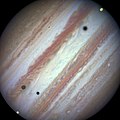Артовкс:Galilean satellite triple conjunction 2015-01-24 (right).jpg

Васенце файла (1000 × 1000 пиксельть, файланть сталмозо: 584 Кб, MIME типезэ: image/jpeg)
Те файлась на Викискладе-стэ ды мереви тевс нолдамс лия теварсевкссэ. Ланганзо сёрмадовксось лопасто ёвтнемась невтезь ало.
Нурькинестэ
| СёрмадомаGalilean satellite triple conjunction 2015-01-24 (right).jpg |
English: Firing off a string of snapshots like a sports photographer at a NASCAR race, NASA's Hubble Space Telescope captured a rare look at three of Jupiter's largest moons parading across the banded face of the gas-giant planet: Europa, Callisto, and Io.
These so-called Galilean satellites (named after the 17th century scientist Galileo Galilei, who discovered them with a telescope) complete orbits around Jupiter ranging from 2 days to 17 days in duration. They can commonly be seen transiting the face of Jupiter and casting shadows onto its cloud tops. However, seeing three moons transiting the face of Jupiter at the same time is rare, occurring only once or twice a decade. The Hubble image on the left shows the beginning of the event, which took place on January 24, 2015. From left to right the moons Callisto and Io are above Jupiter's cloud tops. The shadows from Europa (not seen in the image), Callisto, and Io are strung out from left to right. Near the end of the event, approximately 42 minutes later (right-side image), Europa has entered the frame at lower left. Slower-moving Callisto is above and to the right of Europa. Fastest-moving Io is approaching the eastern limb of the planet; its shadow is no longer visible on Jupiter. Europa's shadow is toward the left side of the image, and Callisto's shadow to the right. (The moons' orbital velocities are proportionally slower with increasing distance from the planet.) Missing from the sequence is the moon Ganymede, which was outside Hubble's field of view and too far from Jupiter in angular separation to be considered part of the conjunction. The moons in these photos have distinctive colors. The ancient, cratered surface of Callisto is brownish; the smooth icy surface of Europa is yellow-white; and the volcanic, sulfur-dioxide surface of Io is orange. The apparent "fuzziness" of some of the shadows depends on the moons' distances from Jupiter. The farther away a moon is from the planet, the softer the shadow, because the shadow is more spread out across the disk. The images were taken with Hubble's Wide Field Camera 3 in visible light. |
|||
| Шка | (released 5 February 2015) | |||
| Лисьмапря | http://hubblesite.org/newscenter/archive/releases/2015/05/image/b/ and http://hubblesite.org/newscenter/archive/releases/2015/05/image/c/ (see also http://heritage.stsci.edu/2015/05/index.html) | |||
| Арсиця | NASA, ESA, and the Hubble Heritage Team (STScI/AURA) | |||
| Лият версият |
|
Лицензиянь теема
| Public domainPublic domainfalsefalse |
| Этот файл находится в общественном достоянии (англ. public domain), так как он был создан NASA (Национальным управлением по аэронавтике и исследованию космического пространства). Политика авторского права NASA гласит, что «Материал NASA не защищается авторским правом, если не указано иное». (См. Template:PD-USGov, страницу политики авторского права NASA или политику использования изображений JPL.) |  | |
 |
Предупреждения:
|
Файлань история
Лепштяк чинть/шканть лангс се шканть эйстэ файланть неемга.
| Чи/Шка | Вишка невтевкс | Кувалмот | Совиця | Мельполадкс | |
|---|---|---|---|---|---|
| неень шкань | 17:02, 19 Даволковонь 2021 |  | 1000 × 1000 (584 Кб) | Charlestpt | File:Galilean satellite triple conjunction 2015-01-24.jpg cropped 50 % horizontally using CropTool with lossless mode. |
Файлань тевс нолдамо
Арасть лопат, конат тевс нолдыть те файланть.
Файлань эрьва кува тевс нолдамо
Те файлась тевс нолдави истямо викитнень эйсэ:
- «en.wikipedia.org»-со тевс нолдамо
- «fr.wikipedia.org»-со тевс нолдамо
Метаданнойть
Те файласонть улить информациянь башка поладомат, конат путовить цифрань камерасо эли сканерсэ. Бути теемадо мейле файлась витневсь, сестэ кой-кона ладямотне, паряк, а кармить ванновомо меельце невтеманть марто.
| Келе | 1000 пикс. |
|---|---|
| Сэрь | 1000 пикс. |
| Эрьва компонентс зяро битт |
|
| Компрезиень арафтомац | LZW |
| Пикселэнь композициязо | RGB |
| Ориентация | Свалшкань |
| Зяро компонентэнзэ | 3 |
| Горизонтальсэ сеедезэ | 72 точек на дюйм |
| Вертикальсэ сеедезэ | 72 точек на дюйм |
| Максовксонь аравтнема | нюрьхкяня форматсь |
| Тевс нолдазь программатне | Adobe Photoshop Elements 12.0 Macintosh |
| Файлань лиякстомтомань чи ды шка | 12:31, 7 Даволковонь 2015 |
| Exif версиясь | 2.21 |
| Тюс ютко | sRGB |
| Дата последнего изменения метаданных | 04:31, 7 Даволковонь 2015 |
| Цифракстомтомань чись ды шкась | 04:26, 7 Даволковонь 2015 |
| Уникальный идентификатор исходного документа | xmp.did:767D3918392068118083DF440090DADA |

